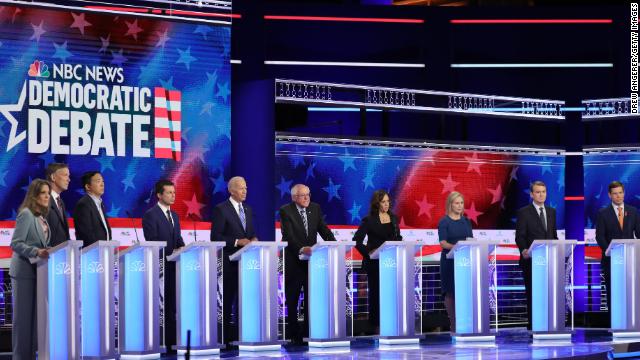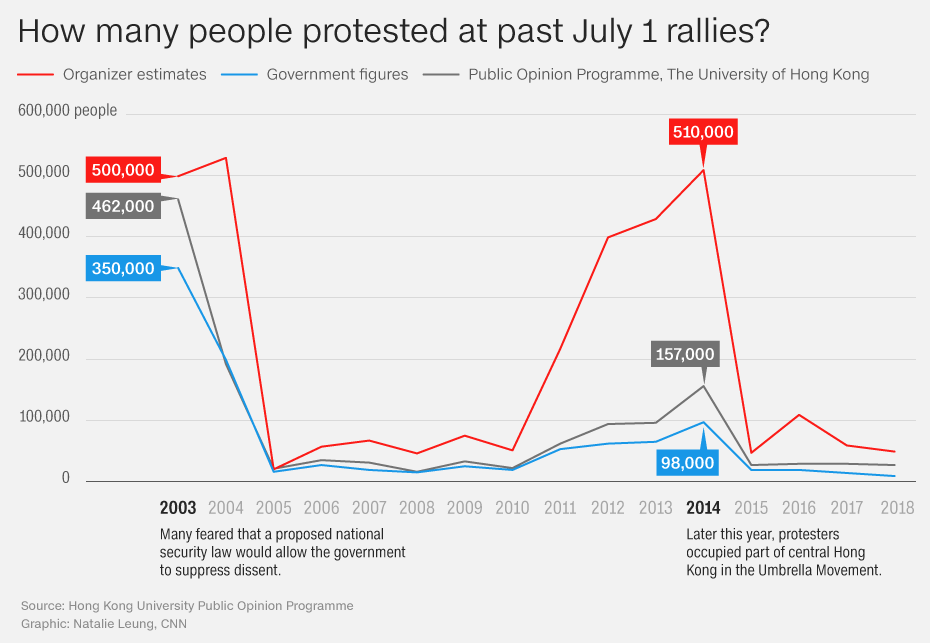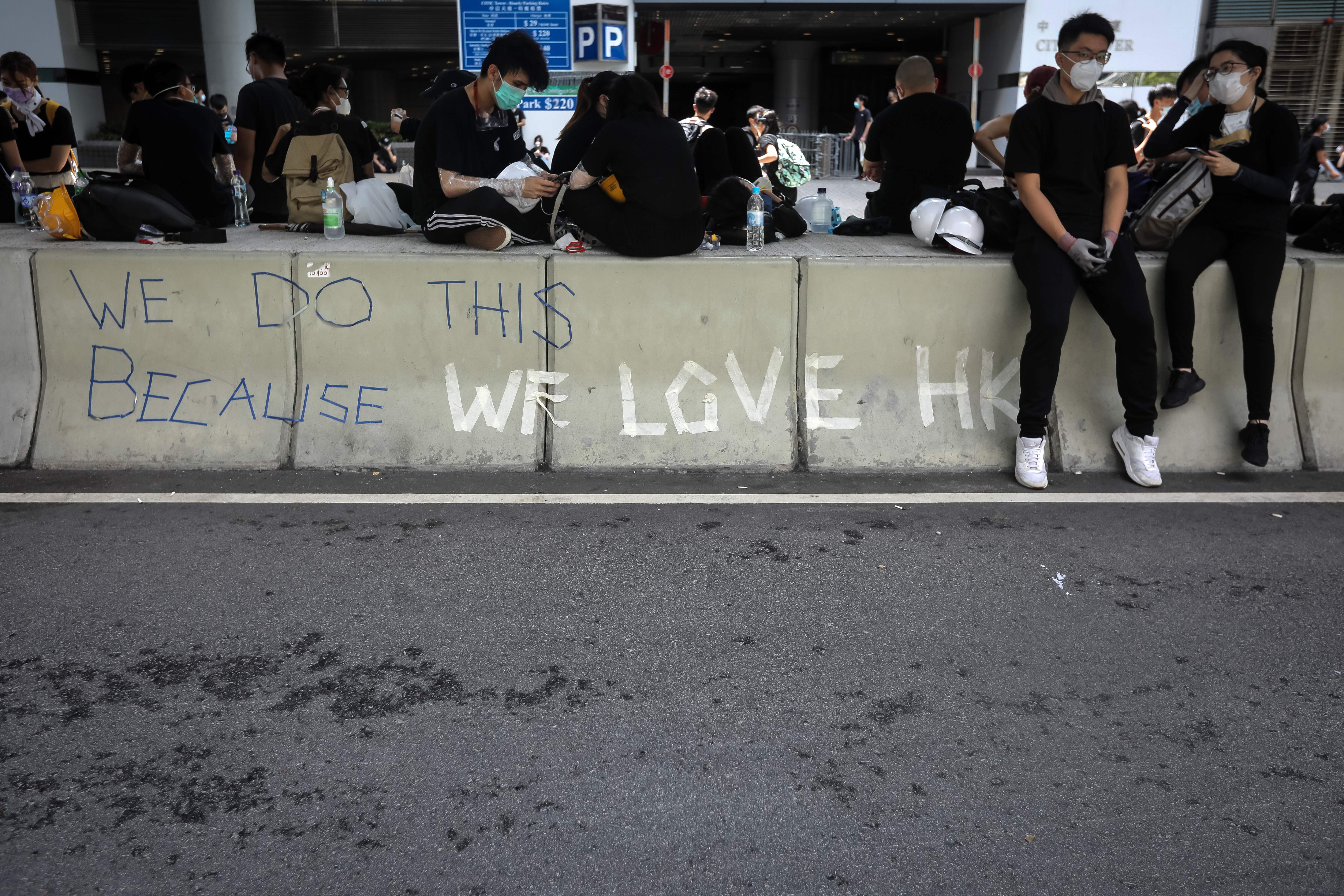Nothing matters more to Democratic voters than picking a nominee with the best chance of beating President Donald Trump, who many party activists consider an existential threat to their values and priorities. But the question of which Democrat is most “electable” against Trump looks murkier and more contested than ever after last week’s debates.
In the race’s early stages, the electability argument mostly benefited former Vice President Joe Biden, polls found. But he faced new doubts after his wobbly performance in last week’s second night of the debates, and in a new
CNN poll conducted after the debates, his support had dropped 10 percentage points from the last survey, in May.
Sens. Kamala Harris of California and Elizabeth Warren of Massachusetts gained new fans with their forceful debate performances, and surged to second and third place behind Biden in the new CNN survey, released Monday. But they also immediately faced questions about whether their embrace of unabashedly liberal positions during the sessions — in particular, banning private health insurance, though Harris, as she’s done before, rhetorically obscured her position in the aftermath — had made them less competitive in a general election.
Such whipsawed emotions have become common among Democratic voters as they search for a nominee best suited to beat Trump. Many Democrats have found themselves not only assessing whether a candidate appeals to them personally but also trying to gauge whether the candidate will appeal to other people — Midwestern blue-collar white men who backed Trump, for instance, or young African-Americans who sat out 2016.
In effect, polls and focus groups suggest that many Democrats are approaching the field not only as voters looking to be inspired but also as political consultants looking to be convinced a candidate can win. The problem is that even many of the party’s sharpest political minds aren’t yet sure which candidate — or even whether a more liberal or centrist strategy — has the best chance of ousting Trump.
Voters who are trying to think like James Carville, the renowned campaign manager for Bill Clinton in 1992, might be reassured that he’s as uncertain as they are about which contender is the most electable.
“It’s very difficult,” he said in an interview. “As we say in New Orleans, put me in that number. What you want to see is political skill … someone who can communicate a message in an effective way, and we don’t know who that person is yet.”
Cracks in the Biden foundation
So far, polling shows that Biden has benefited the most from the focus on electability. In a national mid-June
Monmouth University poll, Biden significantly led the field when likely Democratic primary voters were asked to rank each candidate’s chance, on a 1-10 scale, of beating Trump. Fifty-nine percent of Democratic voters ranked Biden’s chance of beating Trump in the three highest categories on that scale (8 or above).
No one else finished that close: 39% ranked Sanders in the top three categories, 32% Warren, 24% Harris and just 17% South Bend, Indiana, Mayor Pete Buttigieg. As usual in this year’s polls of Democratic voters, Biden’s advantage on electability in that survey was especially pronounced with older voters.
But in last week’s debate Biden delivered a performance almost universally regarded as unsteady, when he was challenged most forcefully by
Harris on his record on school busing during the 1970s but also by Sen. Michael Bennet on the deal he cut in 2012 with Republican Mitch McConnell during the “fiscal cliff” triggered by the expiration of the tax cuts that passed under President George W. Bush.
In the new CNN poll, 43% of Democrats picked Biden as the candidate most likely to beat Trump, a strong but not overwhelming result. More impressively, Biden still led among those who had watched the debates. He even led Harris among nonwhite Democrats on that question by more than 6 to 1. But other results showed a crack in his foundation: Among the three-fifths of Democrats in the poll who said they were most focused on finding a nominee who could beat Trump, Biden led only narrowly in the horse race, drawing 23%, compared with 18% for both Harris and Warren.
‘);$vidEndSlate.removeClass(‘video__end-slate–inactive’).addClass(‘video__end-slate–active’);}};CNN.autoPlayVideoExist = (CNN.autoPlayVideoExist === true) ? true : false;var configObj = {thumb: ‘none’,video: ‘politics/2019/06/28/joe-biden-president-trump-barack-obama-immigration-deportations-2020-democratic-debate-nbc-vpx.nbc’,width: ‘100%’,height: ‘100%’,section: ‘domestic’,profile: ‘expansion’,network: ‘cnn’,markupId: ‘body-text_17’,theoplayer: {allowNativeFullscreen: true},adsection: ‘const-article-inpage’,frameWidth: ‘100%’,frameHeight: ‘100%’,posterImageOverride: {“mini”:{“width”:220,”type”:”jpg”,”uri”:”//cdn.cnn.com/cnnnext/dam/assets/190627213453-biden-fists-2020-dem-debate-0627-small-169.jpg”,”height”:124},”xsmall”:{“width”:307,”type”:”jpg”,”uri”:”//cdn.cnn.com/cnnnext/dam/assets/190627213453-biden-fists-2020-dem-debate-0627-medium-plus-169.jpg”,”height”:173},”small”:{“width”:460,”type”:”jpg”,”uri”:”//cdn.cnn.com/cnnnext/dam/assets/190627213453-biden-fists-2020-dem-debate-0627-large-169.jpg”,”height”:259},”medium”:{“width”:780,”type”:”jpg”,”uri”:”//cdn.cnn.com/cnnnext/dam/assets/190627213453-biden-fists-2020-dem-debate-0627-exlarge-169.jpg”,”height”:438},”large”:{“width”:1100,”type”:”jpg”,”uri”:”//cdn.cnn.com/cnnnext/dam/assets/190627213453-biden-fists-2020-dem-debate-0627-super-169.jpg”,”height”:619},”full16x9″:{“width”:1600,”type”:”jpg”,”uri”:”//cdn.cnn.com/cnnnext/dam/assets/190627213453-biden-fists-2020-dem-debate-0627-full-169.jpg”,”height”:900},”mini1x1″:{“width”:120,”type”:”jpg”,”uri”:”//cdn.cnn.com/cnnnext/dam/assets/190627213453-biden-fists-2020-dem-debate-0627-small-11.jpg”,”height”:120}}},autoStartVideo = false,isVideoReplayClicked = false,callbackObj,containerEl,currentVideoCollection = [],currentVideoCollectionId = ”,isLivePlayer = false,mediaMetadataCallbacks,mobilePinnedView = null,moveToNextTimeout,mutePlayerEnabled = false,nextVideoId = ”,nextVideoUrl = ”,turnOnFlashMessaging = false,videoPinner,videoEndSlateImpl;if (CNN.autoPlayVideoExist === false) {autoStartVideo = false;if (autoStartVideo === true) {if (turnOnFlashMessaging === true) {autoStartVideo = false;containerEl = jQuery(document.getElementById(configObj.markupId));CNN.VideoPlayer.showFlashSlate(containerEl);} else {CNN.autoPlayVideoExist = true;}}}configObj.autostart = CNN.Features.enableAutoplayBlock ? false : autoStartVideo;CNN.VideoPlayer.setPlayerProperties(configObj.markupId, autoStartVideo, isLivePlayer, isVideoReplayClicked, mutePlayerEnabled);CNN.VideoPlayer.setFirstVideoInCollection(currentVideoCollection, configObj.markupId);videoEndSlateImpl = new CNN.VideoEndSlate(‘body-text_17’);function findNextVideo(currentVideoId) {var i,vidObj;if (currentVideoId && jQuery.isArray(currentVideoCollection) && currentVideoCollection.length > 0) {for (i = 0; i 0) {videoEndSlateImpl.showEndSlateForContainer();if (mobilePinnedView) {mobilePinnedView.disable();}}}}callbackObj = {onPlayerReady: function (containerId) {var playerInstance,containerClassId = ‘#’ + containerId;CNN.VideoPlayer.handleInitialExpandableVideoState(containerId);CNN.VideoPlayer.handleAdOnCVPVisibilityChange(containerId, CNN.pageVis.isDocumentVisible());if (CNN.Features.enableMobileWebFloatingPlayer &&Modernizr &&(Modernizr.phone || Modernizr.mobile || Modernizr.tablet) &&CNN.VideoPlayer.getLibraryName(containerId) === ‘fave’ &&jQuery(containerClassId).parents(‘.js-pg-rail-tall__head’).length > 0 &&CNN.contentModel.pageType === ‘article’) {playerInstance = FAVE.player.getInstance(containerId);mobilePinnedView = new CNN.MobilePinnedView({element: jQuery(containerClassId),enabled: false,transition: CNN.MobileWebFloatingPlayer.transition,onPin: function () {playerInstance.hideUI();},onUnpin: function () {playerInstance.showUI();},onPlayerClick: function () {if (mobilePinnedView) {playerInstance.enterFullscreen();playerInstance.showUI();}},onDismiss: function() {CNN.Videx.mobile.pinnedPlayer.disable();playerInstance.pause();}});/* Storing pinned view on CNN.Videx.mobile.pinnedPlayer So that all players can see the single pinned player */CNN.Videx = CNN.Videx || {};CNN.Videx.mobile = CNN.Videx.mobile || {};CNN.Videx.mobile.pinnedPlayer = mobilePinnedView;}if (Modernizr && !Modernizr.phone && !Modernizr.mobile && !Modernizr.tablet) {if (jQuery(containerClassId).parents(‘.js-pg-rail-tall__head’).length) {videoPinner = new CNN.VideoPinner(containerClassId);videoPinner.init();} else {CNN.VideoPlayer.hideThumbnail(containerId);}}},onContentEntryLoad: function(containerId, playerId, contentid, isQueue) {CNN.VideoPlayer.showSpinner(containerId);},onContentPause: function (containerId, playerId, videoId, paused) {if (mobilePinnedView) {CNN.VideoPlayer.handleMobilePinnedPlayerStates(containerId, paused);}},onContentMetadata: function (containerId, playerId, metadata, contentId, duration, width, height) {var endSlateLen = jQuery(document.getElementById(containerId)).parent().find(‘.js-video__end-slate’).eq(0).length;CNN.VideoSourceUtils.updateSource(containerId, metadata);if (endSlateLen > 0) {videoEndSlateImpl.fetchAndShowRecommendedVideos(metadata);}},onAdPlay: function (containerId, cvpId, token, mode, id, duration, blockId, adType) {/* Dismissing the pinnedPlayer if another video players plays an Ad */CNN.VideoPlayer.dismissMobilePinnedPlayer(containerId);clearTimeout(moveToNextTimeout);CNN.VideoPlayer.hideSpinner(containerId);if (Modernizr && !Modernizr.phone && !Modernizr.mobile && !Modernizr.tablet) {if (typeof videoPinner !== ‘undefined’ && videoPinner !== null) {videoPinner.setIsPlaying(true);videoPinner.animateDown();}}},onAdPause: function (containerId, playerId, token, mode, id, duration, blockId, adType, instance, isAdPause) {if (mobilePinnedView) {CNN.VideoPlayer.handleMobilePinnedPlayerStates(containerId, isAdPause);}},onTrackingFullscreen: function (containerId, PlayerId, dataObj) {CNN.VideoPlayer.handleFullscreenChange(containerId, dataObj);if (mobilePinnedView &&typeof dataObj === ‘object’ &&FAVE.Utils.os === ‘iOS’ && !dataObj.fullscreen) {jQuery(document).scrollTop(mobilePinnedView.getScrollPosition());playerInstance.hideUI();}},onContentPlay: function (containerId, cvpId, event) {var playerInstance,prevVideoId;if (CNN.companion && typeof CNN.companion.updateCompanionLayout === ‘function’) {CNN.companion.updateCompanionLayout(‘restoreEpicAds’);}clearTimeout(moveToNextTimeout);CNN.VideoPlayer.hideSpinner(containerId);if (Modernizr && !Modernizr.phone && !Modernizr.mobile && !Modernizr.tablet) {if (typeof videoPinner !== ‘undefined’ && videoPinner !== null) {videoPinner.setIsPlaying(true);videoPinner.animateDown();}}},onContentReplayRequest: function (containerId, cvpId, contentId) {if (Modernizr && !Modernizr.phone && !Modernizr.mobile && !Modernizr.tablet) {if (typeof videoPinner !== ‘undefined’ && videoPinner !== null) {videoPinner.setIsPlaying(true);var $endSlate = jQuery(document.getElementById(containerId)).parent().find(‘.js-video__end-slate’).eq(0);if ($endSlate.length > 0) {$endSlate.removeClass(‘video__end-slate–active’).addClass(‘video__end-slate–inactive’);}}}},onContentBegin: function (containerId, cvpId, contentId) {if (mobilePinnedView) {mobilePinnedView.enable();}/* Dismissing the pinnedPlayer if another video players plays a video. */CNN.VideoPlayer.dismissMobilePinnedPlayer(containerId);CNN.VideoPlayer.mutePlayer(containerId);if (CNN.companion && typeof CNN.companion.updateCompanionLayout === ‘function’) {CNN.companion.updateCompanionLayout(‘removeEpicAds’);}CNN.VideoPlayer.hideSpinner(containerId);clearTimeout(moveToNextTimeout);CNN.VideoSourceUtils.clearSource(containerId);jQuery(document).triggerVideoContentStarted();},onContentComplete: function (containerId, cvpId, contentId) {if (CNN.companion && typeof CNN.companion.updateCompanionLayout === ‘function’) {CNN.companion.updateCompanionLayout(‘restoreFreewheel’);}navigateToNextVideo(contentId, containerId);},onContentEnd: function (containerId, cvpId, contentId) {if (Modernizr && !Modernizr.phone && !Modernizr.mobile && !Modernizr.tablet) {if (typeof videoPinner !== ‘undefined’ && videoPinner !== null) {videoPinner.setIsPlaying(false);}}},onCVPVisibilityChange: function (containerId, cvpId, visible) {CNN.VideoPlayer.handleAdOnCVPVisibilityChange(containerId, visible);}};if (typeof configObj.context !== ‘string’ || configObj.context.length 0) {configObj.adsection = window.ssid;}CNN.autoPlayVideoExist = (CNN.autoPlayVideoExist === true) ? true : false;CNN.VideoPlayer.getLibrary(configObj, callbackObj, isLivePlayer);});CNN.INJECTOR.scriptComplete(‘videodemanddust’);
For Harris’ camp in particular, the encounter with Biden represented what some advisers viewed as the opportunity to shift the basis for how voters judge electability. Biden, other Democratic campaigns acknowledge, has benefited from the “poll test”-i.e., surveys that have shown him running better against Trump than the other Democrats. By confronting Biden so firmly, Harris hoped to shift the measurement toward an “eyeball test”: encouraging Democrats to imagine which candidate could best stand beside Trump on a debate stage in fall 2020.
In that sense, the encounter with Biden offered Harris a double benefit: It not only showcased her formidable debating skills, but also demonstrated weakness in Biden. A wide array of Democratic observers instantly concurred that Harris had propelled herself back into the top tier of candidates — a conclusion reinforced, at least for now, by the CNN survey.
But almost as soon as Harris earned plaudits for her confident, dynamic performance, skeptics raised doubts about the substance of her remarks. Centrist voices in the party noted that during the debate
she again stumbled trying to explain whether she would ban private health insurance in a single-payer system. (The answer seems to be yes, except for peripheral services such as cosmetic surgery.) And after the kinetic force of her challenge to Biden faded, others questioned whether Democrats in 2020 really want to debate the efficacy of school busing.
From the other direction, longtime Democratic pollster Stanley B. Greenberg, who conducted focus groups around the debates for the liberal activist organization Women’s Voices, Women’s Vote, predicted from those sessions that Harris could face resistance among African American voters who conflate an attack on Biden with a challenge to Barack Obama’s legacy.
“Assuming Biden is able to get his act together, he has a real base (among African Americans), I believe, grounded in historical dynamics that make it very hard for Harris to make further gains,” Greenberg said. “At some point Biden is going to push back, maybe using the President (Obama), by saying ‘I’m carrying on his legacy.’ ”
As they assess these contrasting considerations, Democrats find themselves second-guessing their choices from day to day, if not hour to hour.
Early during last week’s second night of the presidential debate, I received an excited text from an active Democrat in California. “Kamala for President!” the Democrat wrote. “Harris v. Trump would be Billie Jean King vs. Bobby Riggs.”
The next morning a second text came through. “She won the first debate. She dealt a significant blow to Biden … but did she win Pennsylvania, Wisconsin, Michigan and other swing states? It didn’t take long for anxiety to set in.”
2 vastly different strategies
Beneath these fluctuating assessments of each individual candidate’s skills, Democrats are wrestling with a more basic choice about the best pathway back to the White House.
As the debates demonstrated, the Democratic candidates are now offering two fundamentally different approaches to beating Trump, with variations on each side of the divide.
One group of candidates is stressing the importance of controlling the center of the electorate and winning center-right independents and soft Trump supporters who may have grown disillusioned more with the turmoil than the policy choices of his presidency. To Carville, who leans mostly toward this camp, Trump has provided Democrats a great opportunity to not only win but “win big” because he has failed to expand his base beyond the roughly 45% of voters who backed him in 2016 and Republican House candidates in 2018.
But Carville worries that the Democratic race, with its growing emphasis on policies that appeal to the party’s liberal vanguard, is focusing too narrowly to reach the broad audience that may be available against Trump.
“I think that the country does not want to reelect Trump, and my great worry is Democrats can talk them out of that,” he says. “We are pushing ourselves to a place that’s dangerous when we get to the general election.”
All the candidates who primarily stress the importance of holding swing voters are white. That group is led by Biden, but also includes former Colorado Gov. John Hickenlooper, Sens. Amy Klobuchar of Minnesota and Bennet, and the long-shot options of Rep. John Delaney of Maryland and Montana Gov. Steve Bullock.
That underscores the extent to which the conversation about recapturing swing voters is actually a discussion about how Democrats can improve their performance among white voters, both the ones without a college education who provided Trump’s base in 2016 and the college-educated ones whose recoil from Trump helped fuel the Democratic gains last year.
The competing argument stresses the importance of picking a nominee who can maximize turnout among young people and minorities who loathe Trump but are less likely to vote.
“If you have candidates advocating for a visionary agenda, that’s what is more electable,” says Neil Sroka, communications director for the liberal group Democracy for America. “We know that if we are going to beat Donald Trump we need to bring millions of people to the polls that didn’t vote in the 2016 election, and the way to do that is by having candidates who put forward a bold agenda and has a compelling personal story that brings them there.”
Even this camp that focuses on mobilization contains two branches. Sanders and Warren envision energizing this turnout surge with a sweeping progressive agenda centered on a government-run single-payer health care system, free public college and big tax increases on the wealthy.
Peering at the tea leaves
Another group of mobilization-focused candidates are offering a somewhat more restrained agenda and betting on energizing new voters because they embody demographic and generational change. Those contenders include Harris and Sen. Cory Booker of New Jersey, Buttigieg, former Housing and Urban Development Secretary Julian Castro and the long-shot younger House members in the field, including Seth Moulton of Massachusetts and Eric Swalwell of California.
The lines between these approaches are not inviolate. Harris edges close to Warren and Sanders in the leftward lean and ambition of her agenda; Buttigieg, though a powerful symbol of change as a gay millennial candidate, tilts more toward the centrists than the progressives in his agenda and demeanor. And every candidate hopes, at least to some extent, to both mobilize nonvoters and persuade swing voters.
“Real elections evolve,” Greenberg said. “You are at a point in the race where people are carving out their space early in the process, with a lot of candidates … but I wouldn’t assume those strategies don’t become blended as you move toward the election, after you’ve established your early wins and are running more broadly. I wouldn’t assume that this is where they end.”
But there’s no question that candidates put differing emphases on the two sides of that equation. If the party picks Biden or Klobuchar as the nominee, for instance, that would represent a greater bet on recapturing swing voters than picking Harris or Warren, who might be more successful at mobilizing nonvoters.
The conundrum is that no one can convincingly say today whether the strategy of mobilizing nonvoters is more likely to beat Trump than a focus on trying to persuade swing voters who may be tiring of him.
Post-election analyses in 2018 found that Democrats did a great deal of both — though converting former Trump voters was a more important part of their success than many realized at the time. Whether Democrats can replicate that success with Trump himself on the ballot, though, is another question — one of many for which there are no reliable answers right now.
New forecasts from the nonpartisan
States of Change project offers similarly mixed messages. The projection that minorities are likely to increase their share of the national vote by 2 percentage points again in 2020, while non-college whites decline by an equal amount and college-educated whites remain stable, might encourage a mobilization strategy. But the group’s forecast that whites, many of them older, will still cast just over 80% of the 2020 votes in the critical states of Michigan and Pennsylvania, and nearly 90% in Wisconsin, offers evidence for those who want to focus on persuading swing voters.
“The bigger thing is nobody really knows what’s electable or not,” Sroka said. “Electability is this notion we know what voters want. One of the silver linings of 2016 is people are finally starting to understand that politics and political change are not linear, and that things that are very surprising happen all the time. … By any measure, Donald Trump should have not won the 2016 election, but he did, and I think that is forcing many people to change their mind about what is electable and what isn’t.”




























